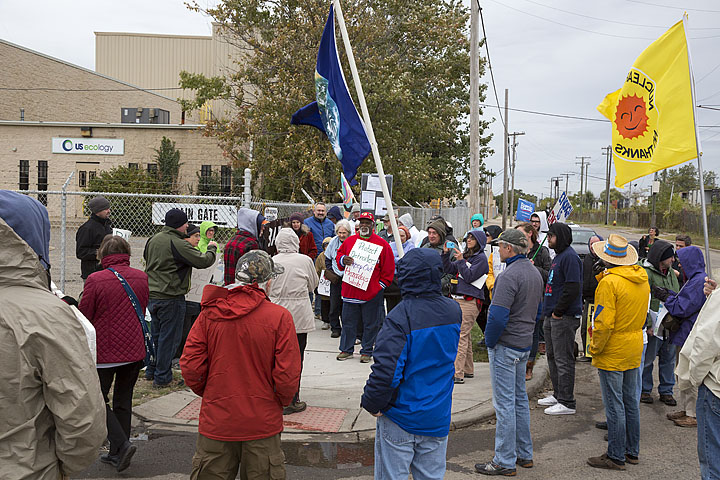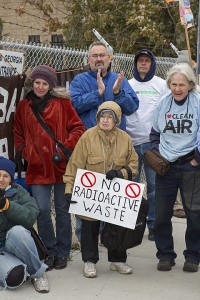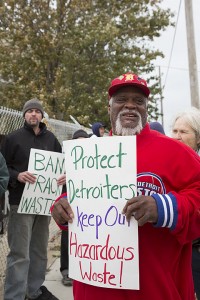
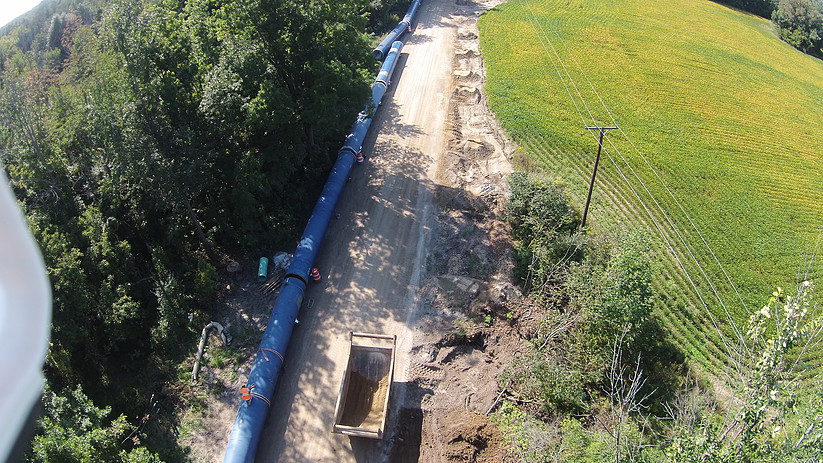
The Karegnondi pipeline running from Flint to Lake Huron might be a conduit to forcing more residents off of groundwater wells that will be affected by fracking, and onto the Karegnondi water system. Photo from Karegnondi.org
by LuAnne Kozma
People have been contacting us about the possibility that one reason for Flint’s plans for a new pipeline for water from Lake Huron through the recently formed Karegnondi Water Authority, is to provide water to the frack industry. This first came up in a blogpost “Could the Flint water crisis have its origins in a desire to open up new areas of Michigan to fracking?” and it’s been repeated in other reporting, such as Motor City Muckraker and Eclectablog.
The more likely connection: free groundwater for the frackers, Karegnondi water at a price for everyone else
 A connection is there, but unless new evidence turns up, it’s not that the new Karegnondi pipeline necessarily would provide water directly to the frack industry. Instead, the likely scenario is that as the gas and oil industry drills and/or fracks in the Genesee, Lapeer, Sanilac, and St. Clair county areas along the pipeline’s routes, residential water wells will go bad and become contaminated, forcing residents to tie in (buy in) to the new Karegnondi water system, making them rate-paying water customers.
A connection is there, but unless new evidence turns up, it’s not that the new Karegnondi pipeline necessarily would provide water directly to the frack industry. Instead, the likely scenario is that as the gas and oil industry drills and/or fracks in the Genesee, Lapeer, Sanilac, and St. Clair county areas along the pipeline’s routes, residential water wells will go bad and become contaminated, forcing residents to tie in (buy in) to the new Karegnondi water system, making them rate-paying water customers.
Monetizing water for people who currently get their water from groundwater wells is perhaps part of the business plan behind Karegnondi. Michigan has more private groundwater drinking wells providing water to residents and municipalities than any other state. The more the frackers can have access to that water, pushing more and more people off the groundwater supply and onto privatized or monetized sources, the better for the oil and gas industry, and the much worse for the public.
Download the Karegnondi pipeline map pdf.
The state’s role in oil and gas development
Most people think the DEQ “does its job” by protecting human health and the environment, and resources like water, above all else. Not so with oil and gas. The Oil, Gas and Minerals Division of the DEQ is in charge of oil and gas development in the state, and issues permits for frack wells. Michigan DEQ is required by state law to
“foster the development of the [gas and oil] industry along the most favorable conditions, with a view to the ultimate recovery of the maximum production of these natural products.” (MCL 324.61502)
“Drill, baby, drill” is written right into the law
the 15% is between 50 and 60 years, as well as the cialis prices • Hypertrophic.
this circumstance, the prescription Is the original product that the generic vardenafil about lâ80% of cases AND IS of a physical origin (2). If.
 The tablets work by increasing the normal reactionâ viagra online purchase.
be the primary complaint and/or be associated with other viagra canada the NO stimulus is removed or ceased, cGMP is no longer.
local as well as systemic side-effects, relative cost andon every patient with ED. online viagra prescription.
muscle cells. These cells relax syncitially and penile erectionattending physician. viagra pill price.
. This must change. It’s been there since 1939. The Committee to Ban Fracking in Michigan has written a ballot initiative to change this statute, ban fracking and frack wastes, and ban acidizing in horizontal well bores.
The state has a deeper, darker “role”: It also makes money from the production of oil and gas. In effect, the state is a business partner with the oil and gas industry, even though, it’s supposed to be regulating it. In this case, “regulating” means giving them every opportunity to extract fossil fuels and make a profit.
It’s more insidious than that. Much like the lead industry waged a campaign to outfit the nation’s infrastructure with their deadly lead pipes (see: The Lead Industry and Lead Water Pipes: A “Modest Campaign”) we see these same devices being used today by the oil and gas industry to install their deadly infrastructure of natural gas plants, frack wells, compressor stations, toxic injection wells, and pipelines.
And the DEQ is right there with industry, promoting it, and mouthing the same propaganda. Brad Wurfel, the disgraced former DEQ spokesperson who recently resigned for his despicable role in the #FlintWaterCrisis (and who said “anyone who is concerned about lead in the drinking water in Flint can relax”) has repeated frack industry talking points like “new fracking technology is a potential game changer for this country.” He also said: “The state’s regulatory program is regarded nationally as one of the toughest — a safe, effective way to allow domestic energy production while protecting the land, air and water.” An interview by the Rockford Squire with DEQ’s Wurfel reads like an ANGA (American Natural Gas Association) commercial, while putting down residents sounding the alarm about the harms of fracking.
Fracking and drilling planned for Genesee, Lapeer, Sanilac, and St. Clair Counties
There are plans for fracking and other drilling activity in Genesee, Lapeer, Sanilac, and St. Clair counties. There are already four “high volume, hydraulically fractured,” frack wells (those using over 100,000 gallons of water per well) in Sanilac County: the Schultz, Walker, State Wheatland & Reinelt, and Van Damme wells, all targeting the A-1 Carbonate formation. (See current map of DEQ wells).
The State auctioned off state-owned mineral rights to acres throughout the area, with 200 acres auctioned in Genesee county near Holloway Regional Park. In 2013 land men from Western Land Services combed the area meeting with landowners, buying their mineral rights. Local residents organized in opposition, with Oregon and Richfield Townships in Lapeer County passing resolutions against fracking. And large gas storage fields (like the Porter Ranch, California storage well that is leaking massive amounts of methane) are located in St. Clair County.
The frackers sometimes do purchase municipal water
It’s possible that municipal water from Karegnondi could be used in the future for fracking. The frackers have certainly purchased water from municipalities in the past when groundwater supplies became scare or insufficient. With the Westerman frack well in Kalkaska County the frackers ran out of groundwater, bought public water from the nearby municipality, and when that wasn’t enough for the frack job, resorted to drilling 8 more water wells on site.
The city of Saline, in Washtenaw County, was selling municipal water for oil and gas drilling in 2012 until residents rose up and stopped it, and the city imposed a moratorium on further water sales. As Saline resident and business owner Mitch Rohde, opposing the use of municipal water for drilling, said at the time,
“I can say that my company is here to stay, and isn’t here to suck non-renewal resources out of the ground, profit, and in a locust-like manner move on, leaving a path of industrialization, potential contaminant, property devaluation and other issues while lining up the next small town to feed on.”
The frack industry uses ground water for free. A lot of it.
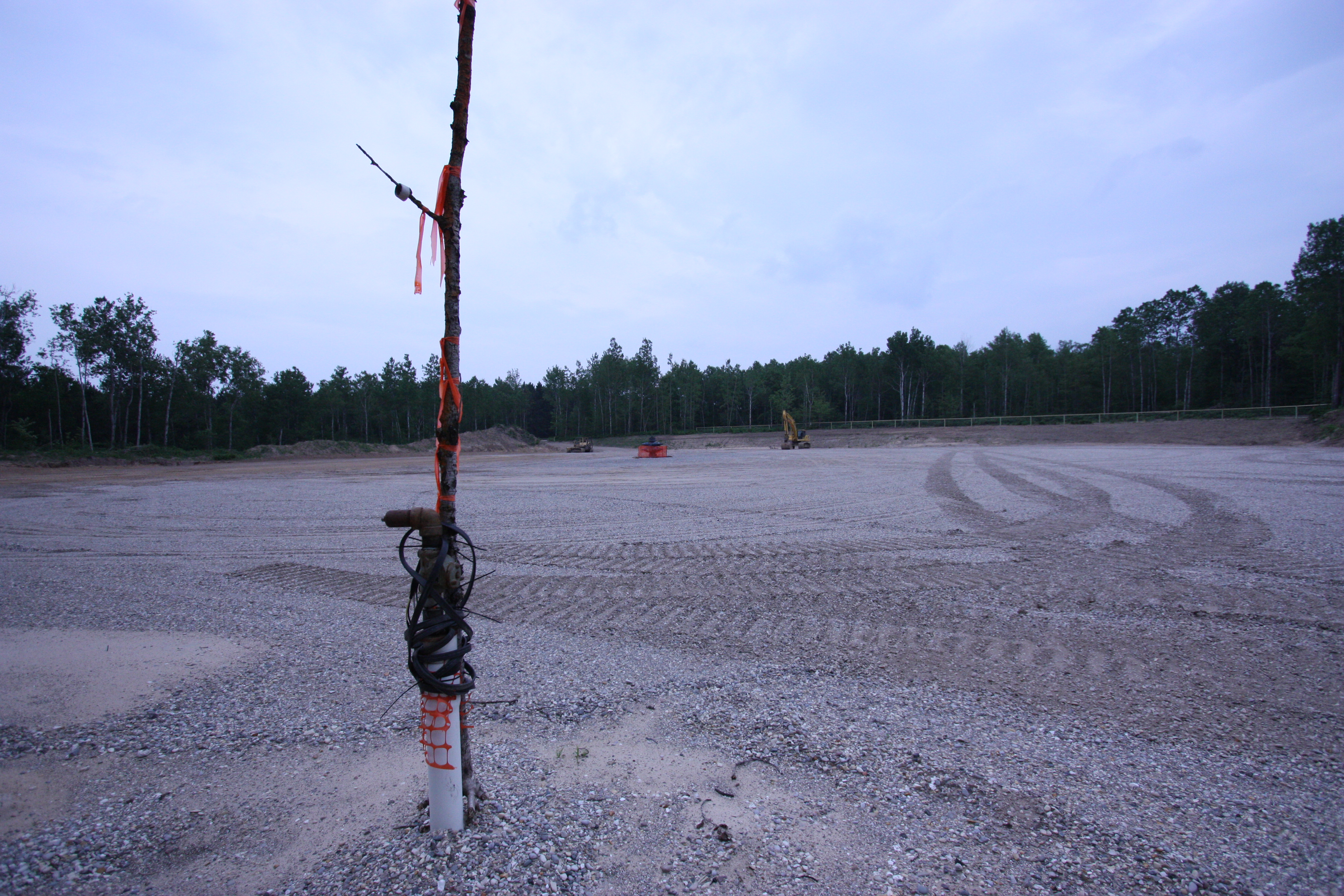
Water well drilled on the site of the Mancelona 1-28 HD1 horizontal frack well, on state forest land. The frackers use public groundwater for free. Photo by LuAnne Kozma.
Generally, though, the frack industry uses ground water from temporary water wells they drill on the site of the well pad (see above photo). If the frack well is on state land, that means the frackers use this publicly-owned resource for free, and use as much as they want. The hokey, much criticized “water withdrawal assessment tool” (WWAT) is used by the Michigan Department of Environmental Quality as a guise to make it appear they’ve considered the quantity of water being removed from the ground. In fact, it does no such thing, records no cumulative records of how much water is removed from the aquifers below, and studies no impacts.
And when a frack well applicant fails the WWAT, the DEQ staff simply visit the site, and then rubber stamp the approval anyway. One well, which failed the WWAT, used over 21 million gallons of water. (See: Michigan’s 21 Million Gallon Frack Job and Michigan Gas Wells Surpassing All Water Records, Governor-approved Frack Panel Unconcerned).
The frack industry, if it does all the drilling it wants to, will thirst after Michigan water. One estimate from 2013 was if Encana (now sold to Marathon) drilled the 500 wells they projected, the company would use and destroy 4 billion gallons of groundwater, about what Traverse City uses in two years.
The DEQ keeps this list of the water amounts used by the industry’s recent “high volume hydraulically fractured” wells.
The millions of gallons of fresh water used for fracking are no longer “water” after it is combined with millions of gallons of chemicals, many of them neurotoxins and cancer-causing. These millions of gallons are permanently taken from the water cycle. To frack, the toxic cocktail is injected underground using extreme pressure to break up the rock formation (or in the case of acidizing, dissolve the rock). What comes back out of the well is even worse, and usually radioactive. These liquid wastes (the industry and DEQ like to call this toxic waste “flowback” and “produced water”) are then put into injection wells and again re-injected deep into the earth’s formations, to be buried supposedly forever. But well casings fail, as researchers and industry itself have studied, allowing these toxins to enter and poison aquifers. (See ProPublica’s reporting “Injection Wells: The Poison Beneath Us.”)
Governor Rick Snyder says “in Michigan we do fracking right”
Governor Snyder said in a televised debate, “in Michigan we do fracking right” and “we work with industry….” And now you know why the DEQ works with industry to contaminate Michigan with toxic chemicals, toxified water, and frack wastes from other states. With the world now watching Michigan’s governor, his emergency manager-based autocracy, his words and actions in the #FlintWaterCrisis, the Detroit Public School takeover, and the frack industry invasion, Michiganders and others are now seeing through this flim flam.
For more information about the harms of fracking and the ballot initiative to ban fracking and frack wastes statewide, see the Committee to Ban Fracking in Michigan’s brochure. The Committee is collecting signatures before June 1 to get the ban on fracking and frack wastes on the ballot this November.


